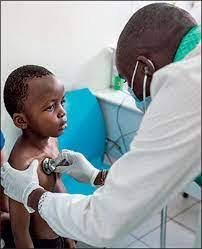By Abujah Rachael, News Agency of Nigeria (NAN)
A 12 year-old girl identified as Maria was among the children diagnosed with TB during a screening outreach at her primary school in Lagos.
The outreach was organised by the USAID-supported Institute of Human Virology Nigeria Tuberculosis Local Organisations Network 3 (IHVN TB-LON 3) Project Community Mobilisation.
Prior to her diagnoses she had significant weight loss and coughed for more than two weeks but was only treated with cough syrup at the hospital.
Narrating her ordeal, Maria said she used to feel weak but after the treatment she felt better.
According to her afterwards, she was strong enough to participate in a state-wide competition and emerge first in the Physical Health Education subject after completing her treatment.
Researchers say understanding the factors that influence tuberculosis (TB) treatment outcomes in children is the key to designing interventions to address them.
According to the World Health Organisation (WHO), TB is one of the leading causes of death globally in spite of being preventable, treatable, and curable.
A report by the UN agency says TB remains one of the most serious infectious diseases affecting children, with an estimated 1.2 million cases and more than 215,000 deaths in children under 15 years of in 2021.
Children under the age of five dominate that figure.
As part of the Sustainable Development Goal (SDGs) agenda world leaders have committed to ending preventable child deaths by 2030.
In spite of the commitment, nearly 700 children die daily from TB, 80 per cent of those before reaching their fifth birthday.
Effective and safe treatment of TB exists. Experts say they can avert most of the deaths. Unfortunately, less than five per cent of the children who need the receive access.
The TB situation in Nigeria is not different from the global picture. A 2022 WHO global TB report indicates that with an estimated 69,000 cases in 2021Nigeria accounts for the fifth highest burden of childhood TB in the world.
According to UNICEF, child deaths from TB ultimately result from four key gaps, namely the prevention, detection, treatment, and research and investment gaps.
“Research and investment gap that signifies failure to prioritise research and investment focused on the needs of children with or at risk of TB”, the UN agency said.
Many children die needlessly every year from this preventable, diagnosable, treatable, and curable infectious disease,” said Dr Lucica Ditiu, Executive Director, Stop TB Partnership.
Stop TB Partnership is an UN-hosted organisation that serves the needs and amplify the voices of the people, communities, and countries affected by TB.
“This ongoing tragedy is simply not acceptable. We owe it to our children to protect them at all costs from falling prey to this deadly disease”, she said.
Dr Thomson Nduka, a Public Health expert said that the ability to identify and diagnose cases remainss uboptimal and is particularly poor among children and persons living with HIV.
Nduka said that there is a need for better and shorter treatment regimens to improve case management.
“Efforts should be made to improve TB treatment outcomes in children by ensuring early and accurate diagnosis.
“This should also include focused training of health workers on childhood TB-HIV care, and effective adherence counseling of caregivers,” he said.
Dr Abiola Risikat, said the Institute of Human Virology, Nigeria, launched TB screening outreaches in primary and secondary schools in Badagry Local Government Area (LGA) of Lagos State was part of efforts towards early detection of TB among children.
Risikat is the Project Community Mobilisation Advisor of IHVN TB-LON 3.
“In the first phase of implementation spanning Sept 2021 to Dec 2021, a total of 914 presumptive child TB cases were screened, 53 child TB cases were diagnosed, and 51 were started on treatment.
“Between January to March 2022, 26 child TB cases were diagnosed and 24 started on treatment as well. Out of the 26 child TB cases diagnosed, four were drug-resistant TB cases’’, she said.
According to Dr Chukwuma Anyaike , the Federal Government, has taken initiatives to close the identified gaps in Nigeria’s child and adolescent TB response by rolling out a new roadmap for that purpose.
Anyaike is the National Coordinator, National Tuberculosis, Leprosy and Buruli Ulcer Control Programme (NTBLCP).
He said the initiative prioritises the integration of TB care with Reproductive, Maternal, Newborn, Child, Adolescent Health plus Nutrition (RMNCAH+N) and HIV services.
“The roadmap recommends that TB services for children be mainstreamed into existing child health services, and more responsibility and accountability be given to primary care providers.
“We shall focus on the most vulnerable populations, ramp up our commitment, investment and actions, and follow this new roadmap to a logical,” he said.
Dr Mathew Agada, a paediatrician, said to meet End TB targets, it was imperative to break the chain of transmission by closing the gaps in TB detection and ensuring that those detected were treated and cured.
“Cost considerations weigh heavily when choosing between different sets of interventions to reach the ultimate goal of ending TB,” he said.
Dr Matshidiso Moeti, WHO Regional Director for Africa, said that the epidemic of tuberculosis among children in Africa had been largely ignored.
Moeti said there is the need for the continent to galvanize action and ensure that no child in Africa is lost to preventable and treatable diseases. (NANFeatures)
**If used please credit the writer and News Agency of Nigeria.


